Table of contents
- What moved the MOTORRAD editorial team in 111 years You know what …?
- Brigitte Haschek
- Rolf Henniges
- Thorsten Dentges
- Thomas Schmieder
- Peter Mayer
- Stefan Kaschel
- Ralf Schneider
- Michael Schumann
- Gerd Mayer
- Gert Thole
- Berit Horenburg
- Markus Biebricher
- Jorg Lohse
- Gerhard Eirich
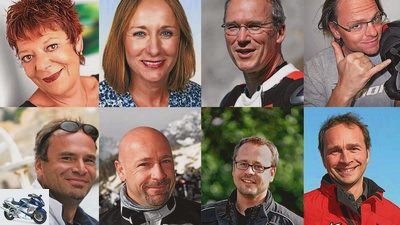
archive
Sports & scene
What moved the MOTORRAD editorial team in 111 years
What moved the MOTORRAD editorial team in 111 years
You know what …?
There are stories that you never forget – funny, bizarre, touching, unique, impressive, unusual and even those that changed a whole life. More than a dozen MOTORRAD editors have sifted through the huge treasure trove of memories that has accumulated over the decades.
Brigitte Haschek, Peter Mayer, Jorg Lohse, Stefan Kaschel, Berit Horenburg, Gert Thole, Thomas Schmieder, Rolf Henniges, Thorsten Dentges, Markus Biebricher, Gerd Mayer, Gerhard Eirich, Michael Schumann
07/28/2014
And everyone has discovered their own personal jewel: record drives on the Bonneville Salt Flats, a wacky North Cape tour, the homage to an ex-colleague or the first test of the legendary Ducati 750 SS – all great moments of journalism and entertainment in the best sense of the word. An exciting journey through time through the fascinating world of two-wheeled reading.
Buy complete article
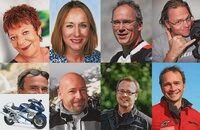
What moved the MOTORRAD editorial team in 111 years
You know what …?
12 pages) as PDF
€ 2.00
Buy now
The MOTORRAD editors Brigitte Haschek, Rolf Henniges, Thorsten Dentges, Thomas Schmieder, Peter Mayer, Stefan Kaschel, Ralf Schneider, Michael Schumann, Gerd Mayer, Gert Thole, Berit Horenburg, Markus Biebricher, Jorg Lohse and Gerhard Eirich report on their most exciting experiences.
Brigitte Haschek
“Nonsense,” growled Limmert. “A journalist doesn’t have to pack, but unpack.” And Limmert, the stubborn, unpacked”.
The hat is his trademark. Just like the hand-rolled cigarettes in the corner of your mouth and the black leather jacket. The young editor Brigitte Haschek is deeply impressed when she meets her then already more mature colleague in the mid-80s: cheerful, strong-willed, unadjusted, individual and sometimes a bit weird – this is how the character of the Limmert brand could be described from the first impression.
And then many years later, when they knew each other better, this farewell present from MOTORRAD colleague Norbert Sorg for the last shift: a cabinet piece of anecdotes and selective illumination of Peter’s alter ego – without the slightest hint of voyeurism, but absolutely authentic. Chapeau, mister.
Thank you for this apt, sensitive and at the same time highly amusing tribute to a unique personality and a great journalist. This Limmert portrait sat like a tailor-made station wagon. And it is still absolutely worth reading today.
Rolf Henniges
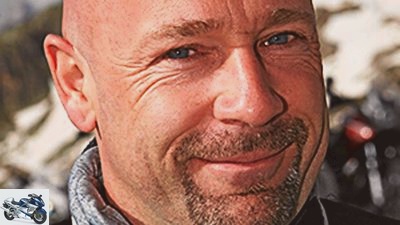
Artist
Rolf Henniges on “Die Ausfahrt” in issue 17/2002.
“Two underpants, shorts, a T-shirt, hiking boots, tools, a six-pack. It all fits into an elephant boy. That is enough”
You intuitively know how to proceed. Author Markus Schliess hammers the essence of the pleasure of motorcycling into short, concise lines. Put simply, he describes a trip to Alsace. Two guys, two Italian bikes, two days off.
“Die Ausfahrt” is a prime example of how a story can convey and transmit passion. Anyone who read it back then called his mates immediately and drove off. Or was annoyed that he sold his motorcycle or that he didn’t have a good friend. Nevertheless, there were no enthusiastic letters to the editor about this brilliant story at the time. The reason: The black and white lead photo in the midst of colorful stories all around in connection with a less lyrical opening credits did not encourage reading at the time. If you didn’t care and read anyway, you were served a really big movie. Would you like a taste? “First hairpin bend up to the Lochen Pass, the road wide and free. The Pirellis are warm, no doubt about it. The front wheel gets a smooth grip when you gently grip the right lever. Axel is very close, as always, as I exit the bends I see his front wheel rotating in the corner of my eye. Carefree pas-de-deux, ballet without choreography and that age-old feeling of being on the hunt. Splendid. Everything dissolves in tension and pressure. ”The entire story looks like it was written in oil. It pays homage to the primal instincts of biking. With everything that goes with it. Tire grip, sloping position, cigarette break, beer after work, friendship and a lot of freedom. Markus Schliess managed to take the reader with him as a passenger.
Thorsten Dentges
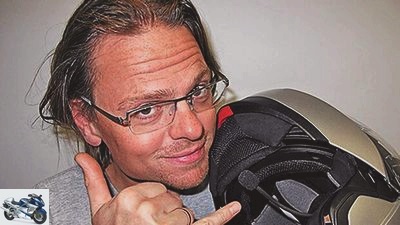
Dentges
Thorsten Dentges on “Blick Ahead” in issue 16/1998.
“It’s called the XL 1000 V and, as a multi-purpose vehicle for road, travel and light terrain, appeals to fans who combine high utility value with driving pleasure”
It was 1998 and the ferry from Hamburg to Newcastle had just cast off. I strolled to the on-board kiosk to buy travel books. Then the revelation: an almost double-sided illustration depicts the travel enduro of my dreams. The presumed sister of the Africa Twin, as editor Axel Westphal was certain at the time, should be called the Honda XL 1000 V and come onto the market in 1999.
So no prototype fiction. I was blown away. Injection V2 with 100 HP and torque ultra broadband, wow! And what it looked like: a sexy mix of rally machine and fat fun bike. For the rest of the vacation I was only slightly interested in my motorcycle and Scotland, Wales and England. My companion suffered because I was barely responsive. I just had in mind how I could get money as quickly as possible. Calculated the sales value of my XRV 750, added up what furniture and stereo would bring in, and planned part-time jobs. Oil rig, day and night taxi driving, malfunctioning on the construction site, legal, illegal, not giving a shit – the main thing is cash. Speculate on the stock market, gamble in the casino, rob a gas station? No question about it, I wanted to be the first to have the new Honda, for that I would have walked over corpses.
How did it go on? In 1999 a new machine actually came on the market. It was called Varadero. What then stood in front of me, however, made me shudder: unsightly, overweight, boring. After the test drive there was not the slightest trace of being in love, from the dream. I got back on my trusty Africa Twin and we had the best motorcycle time of my life until 2005. I kept the tattered notebook with the drawing anyway. Always in the hope that Honda will eventually turn the vision of technical draftsman Stefan Kraft into reality. To this day I have not given up hope.
Thomas Schmieder
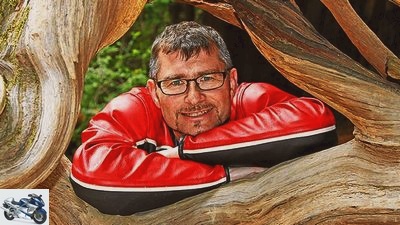
Thomas Schmieder on “Come over here” in issue 20/1987.
“I have barely pulled the motorcycle onto the main stand when a dozen or so keenly curious youngsters in green uniforms surround me”
Officially entering the GDR on a motorcycle from the Federal Republic of Germany was impossible until November 9, 1989. The reason is as simple as it is frightening: when negotiating the transport agreement in 1972, the delegations of both German states simply forgot about two-wheelers, with or without a motor.
But there was a loophole. In the paragraphs, not in the Iron Curtain: If a transit did not lead to West Berlin, but to a third country such as Sweden, Poland or what was then Czechoslovakia, you could apply for an extended transit visa for a full 72 hours. Christoph Altmann reported on such a trip through the workers ‘and peasants’ state in 1987 on the BMW K 75 western motorcycle. This GDR trip inspired me to make a spontaneous detour from my 1988 summer vacation in Sweden to visit relatives in Dresden. Not only was the German-German joyful reunion there among the family. But also the amazement at the 98 hp Yamaha XJ 900 N between loud two-stroke MZ. Thank you for this unforgettable experience.
Peter Mayer

Artist
Peter Mayer on “The very hard way” in issue 18/2004.
“Countless cycling enthusiasts continue to clog the famous passes for many days. What makes up for it: We were there ”
It was supposedly the biggest sports event of all time: Around one million people are said to have made the pilgrimage to L’Alpe d’Huez for the mountain time trial on July 21, 2004 – and MOTORRAD was right in the middle of it. At home in the editorial office nobody believed that at first, and some readers also thought the lead story was a photo montage. But it was exactly like this: the idea then germinated to make a concept comparison on the trail of the Tour de France, i.e. to follow the route. Editor Gert Thole, whose journalistic career began with a bicycle magazine, was not satisfied with that: “I’m going right in there, for the mountain time trial to L’Alpe d’Huez.” A daring plan. Crowds were expected because it was the first and so far only time trial on this legendary stage. 13.8 km, 21 hairpin bends, eight percent gradient, 1080 meters in altitude. The duel between Jan Ullrich and Lance Armstrong was boiling.
But only those who dare win. A group of five drivers plus a photographer set off for the south of France and arrived at the foot of the legendary mountain stage the day before the event. Everything was cordoned off in a wide area, there was apparently no way through. A local gave the decisive tip that you might still get through the back via Villard-Recolas to Huez, roughly in the middle of the ascent. Somehow the MOTORRAD team managed to bypass controls and barriers, and in the late evening they were able to secure a few free square meters as a campsite on the street half a kilometer below Huez. At night, heavy articulated lorries rumbled past in the open lane.
In the early morning the hype started. Hundreds of thousands of people streamed up the mountain. And then the start, the fans freaked out. The entire route was packed with people who only briefly opened a narrow alley for the drivers. At the very end, the top stars with incredible speed. First Jan Ullrich with the typical slow step. And last but not least Lance Armstrong in the irresistible kick. Both passed the test machines set up in a row at a distance of a few centimeters, photographer Dave Schahl captured these moments for eternity.
Stefan Kaschel
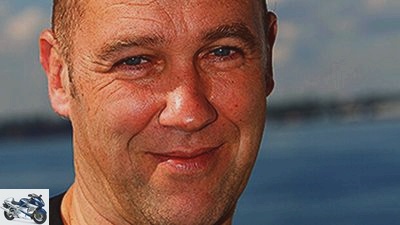
Artist
Stefan Kaschel on “I have to go back to” in issue 6/1997.
“For most of them, Erwin Eimermann is a lovable owl, but for some his unconventional demeanor stinks a lot”
When I remember Erwin Eimermann’s portrait today, even when I read it again, it is not easy for me to say what exactly moves me about this story. In any case, it’s not the team sport. Even then, that was not the focus of interest. And certainly not in that of the author Klaus Herder.
But what then? The person Erwin Eimermann? At Herder you don’t immediately read that either. Distant
the author describes his protagonist and the pathetic circumstances under which Eimermann practices his sport. “In the living area of the soul seller, a kitchen table with a formica top, a sagging upholstered group and large-area pine veneer ensure something like cosiness. Erwin’s 90-year-old mother lies in the middle of the vehicle. The old woman is a serious nursing case and has to be looked after around the clock. Erwin makes a virtue out of necessity and always takes it with him on the run, ”Herder stated soberly.
It is probably precisely this distance that brings this story so close to me. A lead story shows Eimermann how he packs up his shredded team prematurely, quite routinely. Erwin even laughs at it, drinks a beer. On the next page a diaper, somewhere in the keel of the racing team. “Improvising: diaper as a wet swamp,” observes Herder. One suspects: It’s about the diapers for his mother. And that is exactly where she wakes up, my deeply felt sympathy for Erwin Eimermann. The underdog, the loser, the idealist who races for the sake of racing, not to win. One ponders how Bucket Man takes care of his mother for a moment while everyone else is pulling the electric blankets off their tires. And how impossible his endeavor is to bring both under one roof. “The absolute low point followed in 1994,” writes Herder. “In eight races, Erwin never crossed the finish line.” Then a list of the failures of the 96th season. Passenger lost, connecting rod torn off, rear wheel lost, battery broken, ignition malad. But no matter what happens: Eimermann doesn’t let himself get down, laughs in all the pictures, is in a good mood.
It seems that this anti-hero did not even spoil a letter from the IGG, the interest group of racing team drivers, to MOTORRAD. The letter is also printed. The IGG distances itself from Eimermann, from his appearance in the paddock, the condition of his vehicle, from his driving style. Erwin is a nice guy, but it’s a shame for the reputation of this sport. That is finally the point that makes this story so unforgettable for me. She asked me to make a decision. For Eimermann, for his passion – and against the IGG and its efforts to promote the image of team racing. A decision I was happy to make.
Ralf Schneider
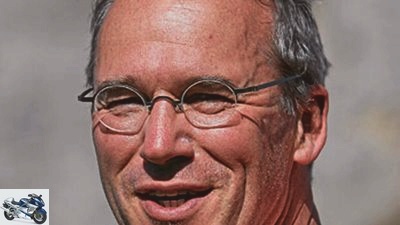
Jahn
Ralf Schneider on “After eight” in issue 20/1984.
“50 motorcycles roar in front of the improvised boxes, which are nailed together like a theater backdrop and only separated from each other by bales of straw. Their din echoes from the walls of the city ”
A long-distance race on a life-threatening track and an orgiastic party all around, even right in the middle of it. Enthusiastic fans and a race management that uses a failure of the timing system to manipulate results. Close to death and lust for life, naivety and malice – Friedemann Kirn’s report from the 1984 edition of the 24-hour race in Montjuïc Park in Barcelona moves between these extremes. The author has put together a gripping and fascinating mixture of information and impressions. You are right in the middle of it all and always there, fluctuating between shudder and awe. On the one hand, I’m glad that this insane race no longer exists. But on the other hand, I think it’s a shame that it no longer provides any material for such reports.
Michael Schumann
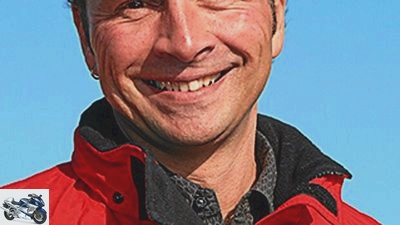
Sdun
Michael Schumann on “Seven days for two euros” in issue 20/2002.
“I can start right now. Repot, clear out and put away. The reward: A night’s camp in the greenhouse and a sumptuous dinner with the family ”
It was in June 2002, in the middle of the World Cup. Brazil beat Germany 2-0 in the final. But that didn’t matter to Rolf Henniges, then just 33 years old and still new to the MOTORRAD team after a break in Australia. He had set out to experience a trip for himself – and then to write one of his best MOTORRAD reports about it. With an MZ SX 125, a sheepskin on the saddle and only two euros in your pocket, 1200 kilometers across Germany. Easily legible for everyone on the aluminum cases: “No money. WORK against eating, drinking, sleeping, refueling “- that was brave. And it was, at least for me, the first milestone on the colleague’s long journey from a strange bald head to a cult writer.
In short, crisp sentences, he sketched his experiences, encounters and lessons from those seven work-intensive days on a whopping 13 pages. He shared a lot of frustration with his readers as well as the pleasure with which he started when someone took pity on him again and again. Regardless of whether it is a Hessian province or a Saxon country, nothing worked every day for a long time. Everywhere he bit granite with his questions about work, was looked at crookedly, taken for a bum or as crazy and potentially dangerous.
Until he thought of giving up. And then something was going everywhere again: scavenging nettle embankments, picking wild strawberries, mucking out the stables, splitting firewood, painting the ceiling, repotting orchids, shoveling bark mulch, waitering, cleaning the kitchen, polishing knight armor, vacuuming the trunk, folding Catholic leaflets. Henniges wasn’t too good for anything. Anyone who knows him knows that it really corresponds to his actual nature.
Why did I remember this story so much? Quite simply: because I wouldn’t trust myself to come up with the idea. And not the execution three times. Because the story is so mercilessly honest. Because it’s full of puns. And because Henniges ’optimism always triumphs over his own pessimism. A real story from life.
Gerd Mayer
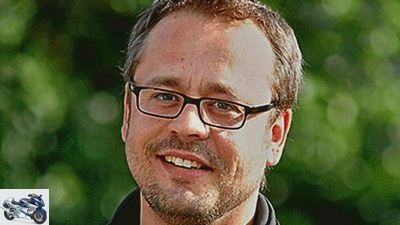
faceCatcher – Bernd Fischer
Gerd Mayer on “Only 72 hours” in issue 23/2005.
“The goal is the goal: an iron globe on a headland in the Barents Sea, the North Cape”
The absolute dream trip, you have to be there. ”His colleague Dentges is committed to convincing people. He raves about never ending midsummer nights, grandiose landscapes and Scandinavian graces. “You don’t want to just sit in front of the graphics screen all the time, do you?” I have to get out, no matter where. What it actually means to heat up to the North Cape in 72 hours from Hamburg with 125 cc is not yet clear to me.
It will be an ordeal: The promised grandiose landscapes blur in the course of this mad ride to monotonous, always the same stretches of land. No wonder, with daily stages of over 1000 kilometers and up to 15 hours in the saddle. The Norwegian girls also disappoint me, because the country’s greatest energy reserves seem to be stored in their love handles. When we actually reach the North Cape in time thanks to favorable weather and brave mopeds, I feel like a world champion. We have to celebrate this! But the lady at the supermarket checkout points out the legal situation: no alcohol sales after 7 p.m. My timer shows four minutes past seven. So the last reserves of the travel provisions have to be enough to douse success: a shot glass of pastis for three men.
Ultimately, I enjoyed every second of this ride in hell. I will always remember this trip.
Gert Thole
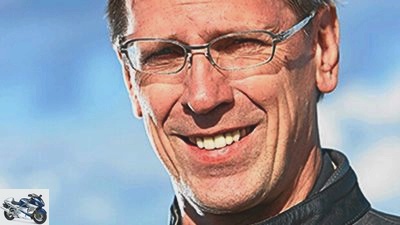
Gargolov
Gert Thole on “Renn-Replica” in issue 7/1975.
“Behind the Winz fairing, the driver hardly notices anything from the wind. Underestimating the speed becomes a problem with consequences, more than one would like ”
Many people can tell about the fact that small coincidences, which initially appear to be incidental events, decisively influence the path of life, when they look back on their lives later. It was the same with me. Sometime in the summer of 1975 I got my hands on a MOTORRAD issue with the first test of the Ducati 750 SS. I was just 18, and the topic of motorcycles was inherently taboo. The stronger the desire for such an unrealizable dream. Back then I soaked up this test, devoured it, it burned itself into my brain. It was not clear to me that a decisive course was being set for my whole life.
But the topic of motorcycles was in my head from then on, especially the fascination for Ducati motorcycles. I had great respect for the people who were allowed to take such tests. Editor Peter Limmert, who wrote this report, was a hero to me at the time, whom one admired and envied. Enjoying this privilege yourself – no thought. Leap in time: In 1992 I have long since owned my dream machine, a Ducati 750 SS vertical shaft, and am a MOTORRAD editor myself. My colleague is Peter Limmert, with whom I was able to work for a few years before he retired. And all because I was so enthusiastic about Limmert’s test and the Ducati 750 SS at the time. In retrospect, it’s a pretty crazy story, right?
Berit Horenburg

Berit Horenburg on “Breathtaking” in issue 12/1979.
“The uphill is so surprisingly strong that I have to pedal with full lungs. The pulse rises – the speed drops rapidly ”
A brilliant idea that Peter Limmert had in 1979. Take a Velosolex around the Nordschleife. A story about decelerating before the buzzword even came up. And a story in which the author laughs at racing drivers in a sympathetic way. When he handed out his ticket for the round, he made a bet that he could cover the 22.83 kilometers in one hour. That’s brave. The friction roller motor that drives the front wheel helps the Velosolex to reach a top speed of 24 km / h on a straight route with 0.57 hp. The Nordschleife also has a difference in altitude of 280 meters and, up to the Hohe Acht, there is a five-kilometer gradient with 17 percent.
The chain smoker Peter Limmert has to kick hard uphill, which takes his breath away. He also strays from the “safe path of the ideal line” with the “very top-heavy bike”. The moped is swaying so much that “even peaceful drivers now need the three-tone horn in addition to the headlight flasher”. And tell him that it is “after all a race track and not a bike path”. As a standing obstacle on the Nordschleife, the moped driver definitely needs dry humor: “In the Fuchsrohre – I now have almost 40 km / h on it – I notice that the ideal line is there for everyone – theoretically. It is more practical to make room for the tire test car that is rumbling into the eye of the needle with over two hundred items. “
Peter Limmert repeatedly measures the time he needs in individual sections of the route. Compare it with times of sprinters or cyclists and of course comes off better every time. Often he has to evade before he is around 68
Minutes reached the goal. Lost bet – but had fun. For this he is given a Radlermab. Which should have been fine with him.
Markus Biebricher
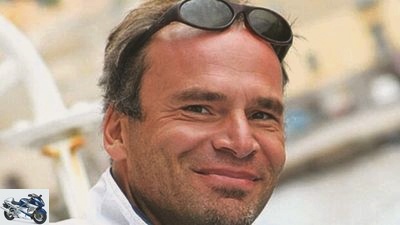
Markus Biebricher on “The fastest place in the world” in issue 21/2007.
“Because there is speed, nothing else is needed”
The paddock of the International Motorcycle Speed Trials lies in the middle of the salt flat, spanned by a sky that stretches as far as to encompass the entire universe. By ten at the latest it is so bright that the light sticks to the eye as a white pain. And it’s so hot that you can drink four liters a day without peeing a drop. In the heat, the contours of distant things become blurred as if on a shaky television picture. There would be nothing in this place if it weren’t for the speed. But because there is speed, nothing else is needed. “
Michael Orth lets his story begin with this scenic image. A story about the longing for speed, about the motorcyclists’ search for limits. The clarity and intensity of the feelings when driving fast and the addictive factor that accompanies the phenomenon of acceleration and speed over and over again. Those who hunt for records with their machines speak of a fantastic feeling, of beauty, of a piece of your own universe, of being one with the motorcycle, yourself, the sky and the salt that is constantly changing, is never the same.
Michael Orth’s language is intense and philosophical. He describes the bizarre characters who want to come true here. The pictures support his language, capture the mood, show a guy who smokes two cigarettes at the same time. Show people who not only let their machines race on the nine-mile salt course, but also their hearts. “When you feel that speed is taking possession of you and this huge white surface opens up in front of you, then it is infinitely difficult to slow down again. You are filled with a kind of peace. It takes your breath away, “says one.
In this story, people give everything for a few seconds, lose themselves in speed. They are people who live passion, move mountains against all odds, who respect life and nature.
Jorg Lohse
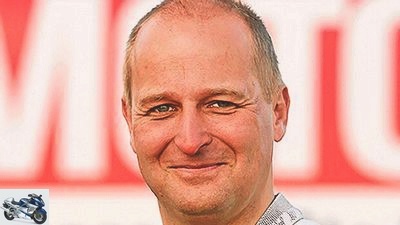
Jahn
Jorg Lohse on “Route 58” in issue 26/2011
“Everyone turns to a person who has just entered the cozy garden restaurant: it is Marco Simoncelli, he is holding his girlfriend Kate in his arms”
There are pictures that you don’t forget. One of them is the MotoGP race of Malaysia in 2011 when Marco Simoncelli crashed. Right in front of Valentino Rossi and Colin Edwards, both of whom can no longer avoid them. The helmet that is literally blown away by its charismatic curly hair.
A few weeks before this event, colleague Rainer Froberg came back from Italy with shining eyes: From the “Italian Legendary Tour”, an annual promotional campaign for the Dainese clothing brand, which was more of an advertising event for the motorcycle. Countless bikers from all over the world who were lucky enough to buy a station wagon or a helmet and let them curve through beautiful landscapes. The icing on the cake is accompanied by tour guides who are otherwise only known from TV or even from historical racing pictures: Max Biaggi, Valentino Rossi, Kevin Schwantz, Carl Fogarty or Italy’s folk hero Giacomo Agostini.
Of course, they caused small crowds at every refueling stop or every passing through town. In 2009, Simoncelli accompanied the Corso for a day. Rainer, who is driving the tour on behalf of the editorial team, does not get to know the bird of paradise you know from the pit lane. Instead, a motorcyclist curving through the northern Italian lake landscape with a big grin, his girlfriend Kate on the pillion seat. And with which you can toast yourself at the end of a long day on the bike in a trattoria. A few weeks later, the charismatic racing driver dies on the circuit in Sepang. The report on the “Italian Legendary Tour” therefore had to pay homage to the number 58 in motorcycle racing. And a story I’ll never forget.
Gerhard Eirich
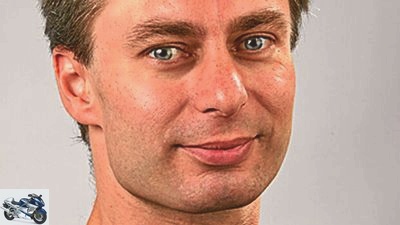
mps photo studio
Gerhard Eirich on the MOTORRAD titles through the ages.
As a MOTORRAD Classic man you inevitably rummage through archives, even if not every day in the very early years of MOTORRAD. I found it difficult to select a single story from the early days as an example. Articles were different back then, the entertainment value was less important than the sometimes somewhat brittle information content. Lead deserts included – pictures were less in the foreground than they are today. Rather, I still find it fascinating how the front pages have changed over the decades and at least tend to reflect the attitude towards life of the time.
The fact that the title always showed the same motif for a long time in the 1920s is a statement in itself: the content counts, the magazine must be recognizable. That changed in the 1930s – the onset of mass motorization and the growing importance of the two-wheeler show that the motorcycle has become popular among the population. Everyday motifs with gas station situations on the cover seem to want to prove this. The 1940s, at least in the first half, were shaped by the Second World War. This, too, does not leave the titles untouched. Motorcyclists, military motifs are not taboo, the motorcycle also has its function in the war machine.
The increasing relaxation, the optimism in the reconstruction, the beginning economic miracle in the 50s lead to a kind of small euphoria, which is reflected in numerous joking illustrations. The new looseness, almost silliness, is spreading. And finally, I can’t get past a magazine from 1969 that shows a motorcycle on the cover that has retained its fascination to this day and has certainly had the most lasting influence on the world of two-wheelers: a Japanese four-cylinder bike called the Honda CB 750 Four. The departure into modern times.
Related articles
-
archive 22nd pictures archive 1/22 … many Kreidler RS wore expressive golf green. archive 2/22 … One of his first candidates in 1935 was a 600 BSA….
-
The best stories from 25 years of MOTORRAD Classic
archive Sports & scene The best stories from 25 years of MOTORRAD Classic 25 years of MOTORRAD Classic A quarter of a century MOTORRAD Classic Content of…
-
100 years of MOTORRAD: Epochal bikes
MOTORCYCLE archive motorcycles 100 years of MOTORRAD: Epochal bikes 100 years of MOTORRAD: Epochal bikes signpost On the way to becoming a myth, it is…
-
Two-wheelers of the editorial team
jkuenstle.de 16 pictures Fisherman 1/16 The editorial team’s two-wheelers: MOTORRAD test editor Thomas Schmieder and his treasures. Fisherman 2/16 The…
-
ADAC Safety Ride with the MOTORRAD ACTION TEAM
to travel Travel offers ADAC Safety Ride with the MOTORRAD ACTION TEAM ADAC Safety Ride with the MOTORRAD ACTION TEAM Driving safety training plus travel…
-
Motorcycle trainings 2020: MOTORRAD action team takes off again
Bjorn Gramm Motorcycle trainings 2020: MOTORRAD action team takes off again Motorcycle training courses 2020 MOTORRAD action team takes off again After…
-
MOTORRAD action team long-distance travel 2016
shepherd to travel MOTORRAD action team long-distance travel 2016 MOTORRAD action team long-distance travel 2016 Breathtaking motorbike holidays…
-
Snowmobiling in Lapland with the MOTORRAD action team
Breakable 46 pictures Breakable 1/46 Snowmobiling in Lapland. Clear your head in deep snow with the MOTORRAD action team. Breakable 2/46 Above the clouds…
-
Second-hand advice: desired bikes from the editorial team
AGcuesta – Fotolia 29 pictures AGcuesta – Fotolia 1/29 In private, the MOTORRAD editorial team does not evaluate motorcycles according to standardized…
-
IDM 2017 at the MOTORRAD action team
IDM Sports & scene Motorsport IDM 2017 at the MOTORRAD action team International German Motorcycle Championship 2017 MOTORRAD action team organizes the…